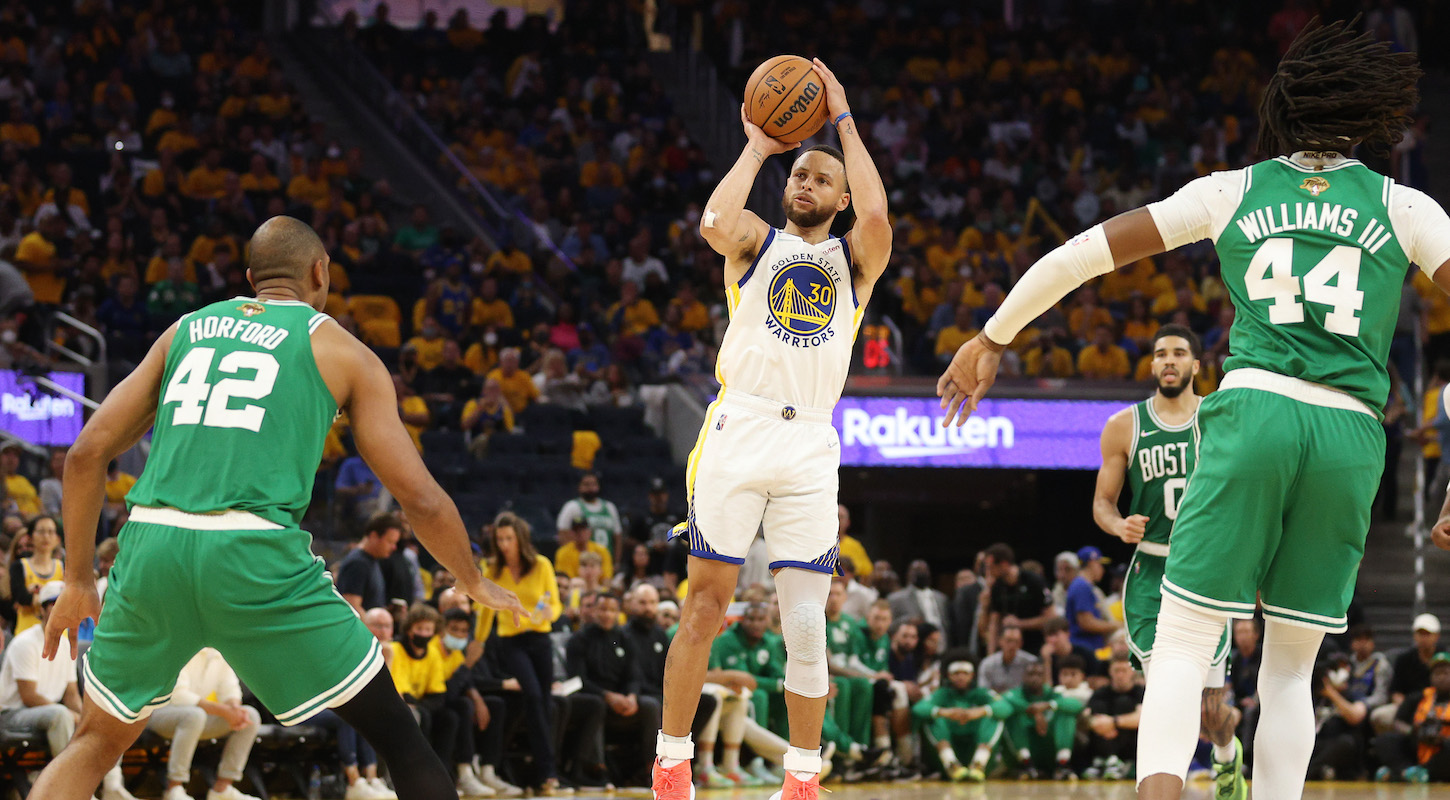The Golden State Warriors won the third quarter of Game 2 of the NBA Finals, 35-14. Then, with Steph Curry on the bench to begin the fourth, they scored eight of the period's first 10 points to run their lead out to 29, and that was that. The Finals are tied a game apiece, headed back to Boston for Wednesday night's Game 3.
The Celtics won Game 1 in large part by going small in the fourth quarter, moving away from the two-big lineups that have made their defense so incredibly stingy all season. In the decisive period of Game 2 the Warriors seemed to make a concerted effort to run away with things while Boston still had their two traditional bigs, Al Horford and Robert Williams, on the floor. They attacked those two (and then even-more-lumbering Daniel Theis) ruthlessly.
Early in the third Thompson caught Horford as his defender as the Celtics matched up in transition, and immediately dragged him through a sprinting baseline run toward an Andrew Wiggins screen. Horford couldn't keep up with the run or get around the screen; by the time Wiggins's defender, Marcus Smart, reacted, Thompson had already shot and made a corner three-pointer. This was classic Warriors basketball—in earlier iterations or against a less-organized opponent, they'd have repeated this action, baiting either Thompson's or Wiggins's defender into anticipating the screen and selling out toward Thompson too early; Wiggins would slip the screen instead of setting it, catch the ball on the move toward the rim, draw a help defender toward him, and kick off a series of light-speed ball rotations against a shredded, scrambling defense, inevitably ending up with an only slightly relocated Thompson coolly splashing a wide-open three six seconds later. They'd spend the rest of the period anticipating and cruelly punishing each of the hapless opponent's adjustments against this basic action, and, well ... they'd win the quarter, by a score of something like 35-14.
They tried it! On their very next possession after the Thompson three, Thompson dragged his defender, this time Jaylen Brown, through the same baseline run—this time toward Horford's man, Kevon Looney. The idea was that Horford, so recently burned by this action, would lunge out to contain Thompson, wrenching Boston's defense out of shape, but Horford kept his cool, Brown fought his way around Looney's screen, and nothing came of it. So, after a kicked-ball rest, the Warriors simply went at Horford again: A series of screens switched him onto Curry at the top of the key, leading to a couple of set-up dribbles and then a step-back three-pointer.
That portended the rest of the quarter, particularly after Smart crashed into Williams's knee a minute later and the latter took a few painful moments getting back up. Golden State mostly ditched the baseline-gauntlet stuff after that, in favor of simpler screens near the top of the key designed to give either of Horford, Williams, or Theis no way of avoiding the Curry matchup. When this didn't lead directly to a Curry bucket, the open look was never more than a couple of hard cuts and clever passes away. Amid the 14 points Curry scored in the period (on progressively more audacious shots), Draymond Green got and bricked a wide-open three a couple passes away from the Curry pick-and-roll; Otto Porter Jr. got, and swished, a wide-open corner three from the same thing a few moments later. Consider that a sort of perverse credit to the Celtics' defense: They'd proven themselves adept enough, big and athletic and organized and committed enough, to force the Warriors into a more brutish and direct version of the template they've used to run away with so many games over the past seven years.
Meanwhile, down at the other end, the Celtics let themselves get baited away from the patience and ball-movement they'd used to tease Golden State's defense apart in the fourth quarter of Game 1 and much of the first half of Game 2. Aggressive chest-to-chest defense by every member of the Warriors did it; give particular credit to Gary Payton II, who made his series debut Sunday night and whose availability means Golden State can put at least one maniacally dogged on-ball defender in their backcourt for all 48 of the game's minutes. Boston's offense devolved into a series of ugly, rushed attempts; unlike the Warriors, who used mismatches to unbalance Boston's defense and find good looks, the impatient Celtics just settled for one-on-one junk. Derrick White dribbled away a possession; Jayson Tatum, so coolly unselfish in Game 1, punted a possession on a hopeless step-back three over the taller Andrew Wiggins; Horford dribbled away a possession; even Payton Pritchard dribbled away most of a possession trying to attack Curry.
The players the Celtics normally rely on to sort calmly through the options seemed to lose faith in their ability to find good looks via passing and movement. Smart threw an out-of-control dribble-drive at Looney early in the shot clock; in the abstract that's fine, a point guard going at the opposing center, but it's not Smart's game, even against centers a lot more leaden than Looney, and it led to the crash into Williams's knee and a turnover. Brown went one-on-four in transition, settled for a hideous off-balance fall-away ... thing ... and bricked it, with 19 seconds left on the shot clock. On Boston's very next possession, again hurrying ahead of too many of his teammates in transition, Brown attempted a frankly hilariously doomed alley-oop lob to the 36-year-old Horford, with about the result you'd expect. And so on, while the Warriors cruised away. This is not how to handle one of the sport's great dynasties making a huge signature push, in its own building, in the NBA Finals.
A minor brouhaha among online Celtics fans after Sunday night's game—and during the parts of the game when their team was getting run off the court—concerned ESPN rules analyst Steve Javie, a former longtime NBA referee, acknowledging (in a roundabout way) that game officials will err on the side of not calling a second technical foul on an important player in a big game. The context for Javie's admission was Draymond Green, who'd already earned a technical in the first quarter, doing some silly Draymond Green instigation after he and Jaylen Brown got tangled up shortly before halftime. Here's that:
It's true, this really was the sort of thing that almost certainly would have earned a rote double-technical if calling it that way wouldn't have resulted in Green's ejection. What's funny is that everybody, very much including Celtics fans, knows that referees operate this way, and knows that the league's savvier pain-in-the-ass types make use of it: Had it been Smart, as he has done innumerable times in his career, weaponizing the referees' reluctance to eject him for the sake of pissing off and/or unnerving a key Warrior, you can close your eyes and hear Boston fans praising him for having the savvy and competitive intensity to wage Total War in the finest of champion traditions. Every fan loves this glitch in NBA refereeing, or at least cringingly bears it, when their own team benefits from it; the very instant it keeps the other team's ornery fucker on the court past a bout of flamboyant shithousing, we all turn into John Goodman roaring "Am I the only one around here who gives a shit about the rules???"
Honestly, it's as good as anything else for explaining Game 2, though I'm not sure any part of what won it for the Warriors is any more easily replicable than the strangling defense and patient shot-creation that won Game 1 for the Celtics. Both teams know their own and each others' (and the referees'!) vulnerabilities, and have learned via painful blowout they can be swept off the court by a mere minutes-long lapse in managing them.






